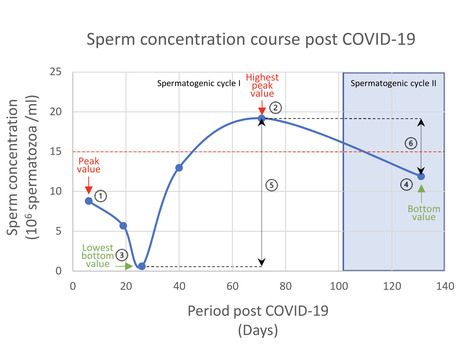Background
Severe acute syndrome coronavirus 2 can invade a variety of tissues, including the testis. Even though this virus is scarcely found in human semen polymerase chain reaction tests, autopsy studies confirm the viral presence in all testicular cell types, including spermatozoa and spermatids.
Objective
To investigate whether the severe acute syndrome coronavirus 2 is present inside the spermatozoa of negative polymerase chain reaction-infected men up to 3 months after hospital discharge.
Materials and methods
This cross-sectional study included 13 confirmed moderate-to-severe COVID-19 patients enrolled 30–90 days after the diagnosis. Semen samples were obtained and examined with real-time polymerase chain reaction for RNA detection and by transmission electron microscopy.
Results
In moderate-to-severe clinical scenarios, we identified the severe acute syndrome coronavirus 2 inside spermatozoa in nine of 13 patients up to 90 days after discharge from the hospital. Moreover, some DNA-based extracellular traps were reported in all studied specimens.
Discussion and conclusion
Although severe acute syndrome coronavirus 2 was not present in the infected men's semen, it was intracellularly present in the spermatozoa till 3 months after hospital discharge. The Electron microscopy (EM) findings also suggest that spermatozoa produce nuclear DNA-based extracellular traps, probably in a cell-free DNA-dependent manner, similar to those previously described in the systemic inflammatory response to COVID-19. In moderate-to-severe cases, the blood–testes barrier grants little defence against different pathogenic viruses, including the severe acute syndrome coronavirus 2. The virus could also use the epididymis as a post-testicular route to bind and fuse to the mature spermatozoon and possibly accomplish the reverse transcription of the single-stranded viral RNA into proviral DNA. These mechanisms can elicit extracellular cell-free DNA formation. The potential implications of our findings for assisted conception must be addressed, and the evolutionary history of DNA-based extracellular traps as preserved ammunition in animals’ innate defence might improve our understanding of the severe acute syndrome coronavirus 2 pathophysiology in the testis and spermatozoa.
Published in Andrology (March 12, 2024):



 Your new post is loading...
Your new post is loading...








